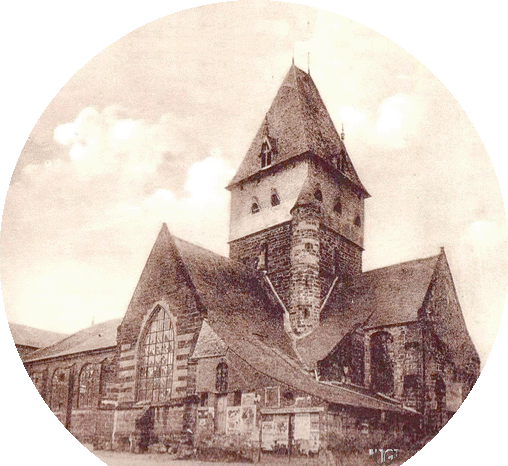|
1st Eglise Notre-Dame
"It
would be in the wake of divergencies between the monks and the inhabitants of
Vimoutiers that Vimonasteriens would have constrained the monks to build a
distinct church named Notre-Dame, Church of Our-Lady. In a bull of the pope
Eugene III in 1147, this first Eglise Notre-Dame, is quoted under the name of
Eglise Sainte-Marie in Vimonasterium. The church is located on the
market
place.
Burned in 1450 during the
fights by
Dunois to drive
the English conquerors out of Normandy,
l'Eglise Notre-Dame
is finally rebuilt in 1458 on its own ruins
(map1779),
then enlarged from 1788 to 1790 with the materials coming from the demolition of
l'Eglise
Saint Sauveur. Then, two sacristies are added, one in the
Southern part of the church in 1808, the other in the northern part in 1822.
Hence, the
church of Notre-Dame is composed of its nave, two collaterals and a
transept including on each side the chapel of the Rosary and the chapel of
Saint Roch, a previous chapel of Ducy founded in 1619 had been removed when the
Church was enlarged and another chapel Sainte Marguerite modified.
In the same time, the cemetery
which surrounds the church is moved and later on in 1842, a new
presbitery is rebuilt in
the yard known as "cour de l'aumône", ie yard of alms.
But in those days, Vimoutiers
is very prosperous due to the
trade of fabrics and the church is said
to be too small. In 1866, Mr Abbe Jenvrin, abbot, assisted by the Town Hall
members and the parish, call upon a subscription for the construction of a new
church. Collecting the necessary funds will take almost 20 years and the first
Church of Notre-Dame will survive until 1897, when at 439 years old, it is
demolished and sold out for its mere building material value.
Thus the first Eglise Notre-Dame and the
then-completed second Eglise Notre-Dame, will have coexisted for two brief
years on the place of Vimoutiers. Florentin Loriot, a Norman poet, composed a
pretty testimony for this :
About two
Notre-Dame on the market place of Vimoutiers.
During the demolition, under a
pillar a treasure is found, composed of 22 gold coins including 12 with the coat
of arms of
Charles VI of France, aka Charles VI The Well-Beloved, or
The Mad and
Charles VII the
Victorious, aka the Well-Served,
father and son, Kings of France from 1380 to 1461, and 10 at the coat of arms of
Henry VI of England King from
1422 to 1471, as well as sarcophagi dated XIIIth century, with their "occupants in good
state (!)" some of them surrounded with objects made of copper from the
Merovingian Time.
Some
elements of this church are indexed by the National Patrimony, such as :
-
An altarpiece, a retable, dated from the XVIth century, found at the back of the choir
behind a 1807 carved group, and exhibited at the
Baron Mackau museum in the
Hotellerie des Moines de Jumieges
in Vimoutiers.
Listed as "not protected
as Historical Monuments", carved stone made, dimension 100x230, representing
episodes of Blessed Virgin Mary's life. This altarpiece and the Hotellerie will
be destroyed by the bombardments of June 1944.
- Protected as Historical
Monument in 1909 :an altarpiece, a retable, from the XVIth century, made of carved stone,
dimension 100x230, the description of which indicates a subfoundation supporting
six pilasters between which niches with decorated shells represent
episodes of Blessed Virgin Mary's life : The Annunciation, The Visitation, The
Nativity, The adoration of the Magi and the Circumcision. Are these two retables an only one
?
- Also destroyed in 1944,
there were 2 golden wooden candlesticks dated end of the XVIIth century.
Some others pieces, transferred in the second
Church of Notre-Dame, were saved from bombardments. Among them :
- An eagle-lectern, 1st half of the XVIIth century,
- A stall, XVIIth century, made of openwork carved
oak, closed by a seat of prayer,
- Two terracotta statues,
Saint Dominique and Sainte Catherine of Siena, probably part of a group
representing the donation of the Rosary, previously in the chapel of the Rosary."


|

▲ |